Mendiani, Mandiani, MANJANI
By Darrin Jackson (2022)
Manjani is a popular traditional rhythm that originated among the Mande peoples of West Africa. Specifically, Guinea is said to be the origin of this song. But just like most things of the Mande peoples, music was not just music. Sound, rhythm, and song were all closely intertwined with the daily life and cultural practices of the Mande. Manjani is a rhythm that was originally played to announce the young women to the community as part of the closing of their rites-of-passage ritual.
The society of elders and experienced woman and mothers would take these young girls from the ages of 6-13 and teach them about life. They instilled in them the wisdom and experience of being women. Upon completion of their passage, a huge festival would be held. They would make elaborate costumes for the young ladies. When the girls adorned themselves in these costumes and masks, they were called “Manjani.” Then the young men would show up at their homes and place the girls on their shoulders as a symbol of protection. They would carry them on their shoulders to the center of the village. The procession is led by a rhythm called Denadon, or Dance of the Young. Once the Manjani take off their masks, they are praised with song, and the rhythm changes to Manjani. Then the new young ladies begin their dance. It can last for several hours, and the dance is high energy, and sometimes acrobatic. It is a celebration!
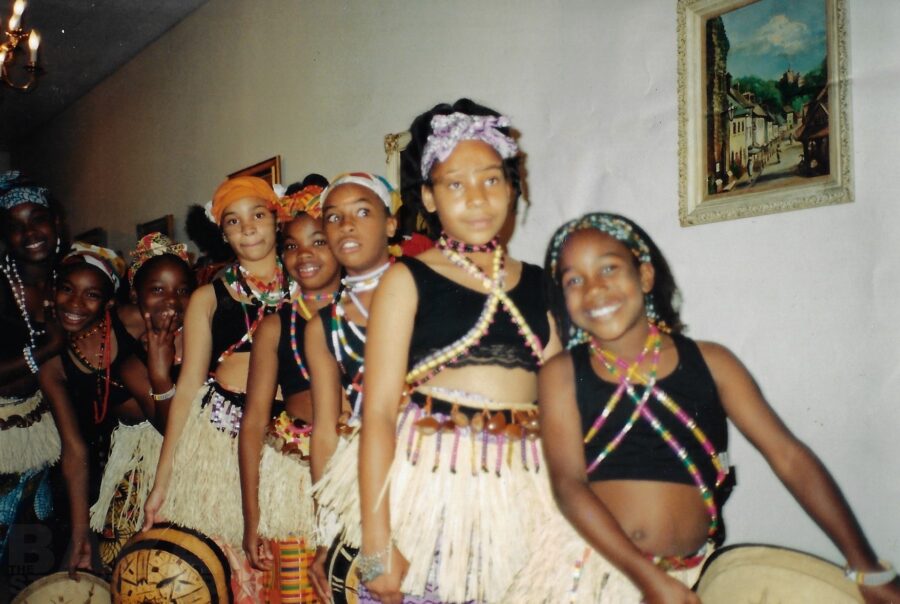
Manjani Rhythm
Today, Manjani is a popular rhythm that is also played for fun at many events and festivals. Because of the many villages and the diaspora of Mande peoples, the song has branched off into a few varied versions. This concept is noted by Dr. Mark Sunkett in his 1995 book Mandiani Drum and Dance. But one thing is consistent, and that is the basic pulse that is often played on the Sangban (also Sangbé), or a singular Dun (also Doun or Diun). This pulse announces to the world that the rhythm is Manjani. It either starts on the first or third portion of the pulse. For the purpose of this introduction, I chose a version that is easy to play and understand to the western sense of music. But I love, play, and teach all versions of Manjani. Manjani is in a Ternary Rhythm, meaning the beats are divided into equal thirds. In contrast, most western music is Binary or divided into equal halves or divisions of two.
The pulse will be reflected in the Bell Line as follows:

The same pattern is repeated on the Sangban or a singular Dun Dun. Remember to mute the 5th note (noted with an “X”).

There are five basic parts to Manjani: Djembe 1, Djembe 2, Kenkeni, Sangban, and Dundunba. The Kenkeni, Sangban and Dundunba are all members of the Dun Dun family and are played along with the Bell. The Dun Duns can also be played Ballet Style, using the three drums as a combined set. I have noted both ways below.

Manjani Break
There is a special rhythmic phrase that is used to start and stop the rhythm. It is called a “break.” This break is also used to signal the dancers when it is time to change steps. See the notation below.
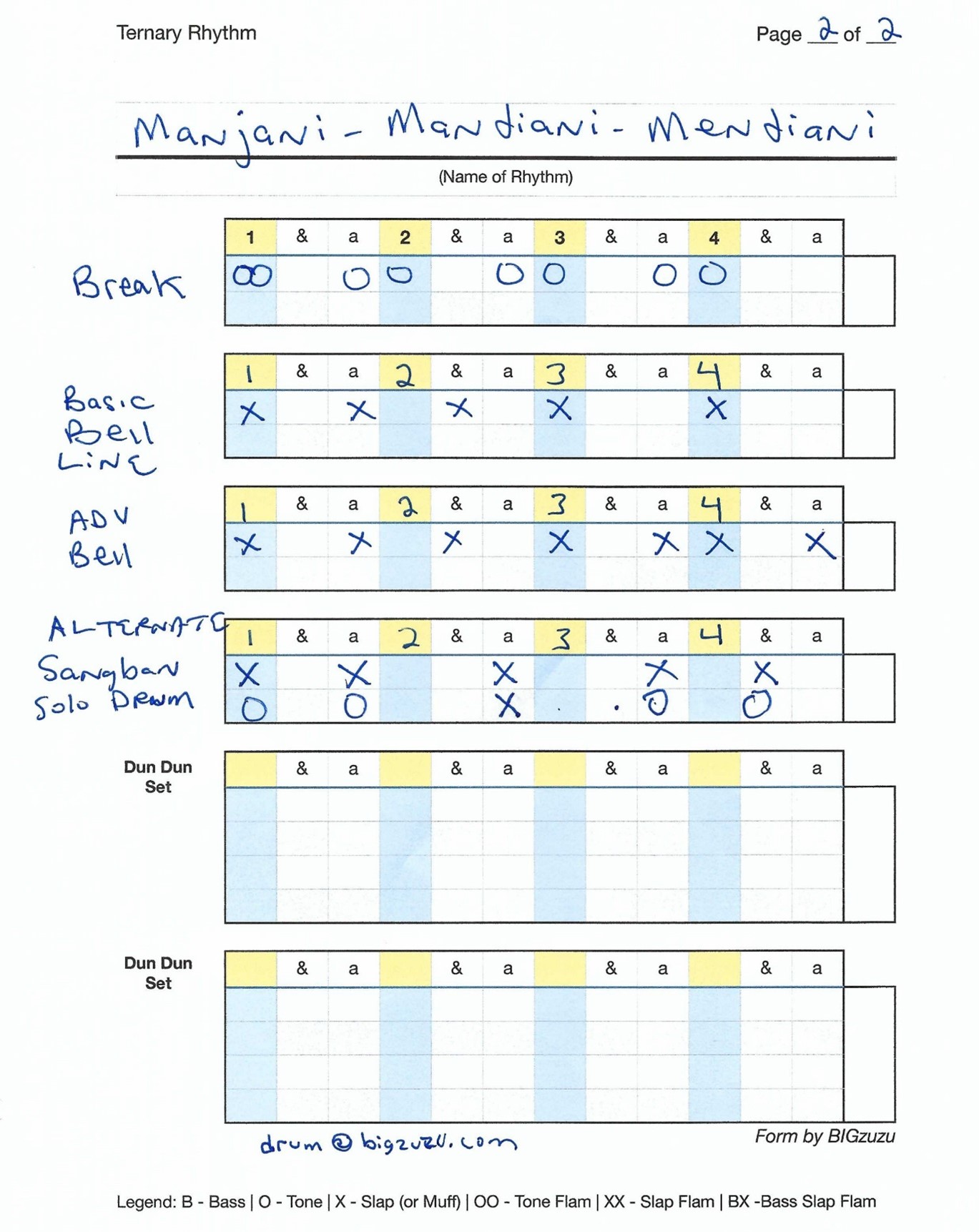
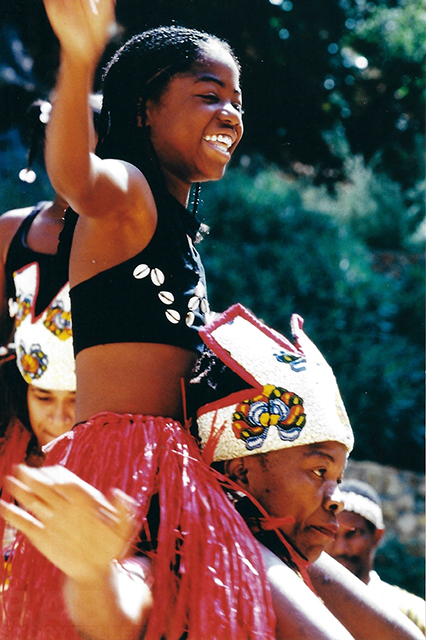
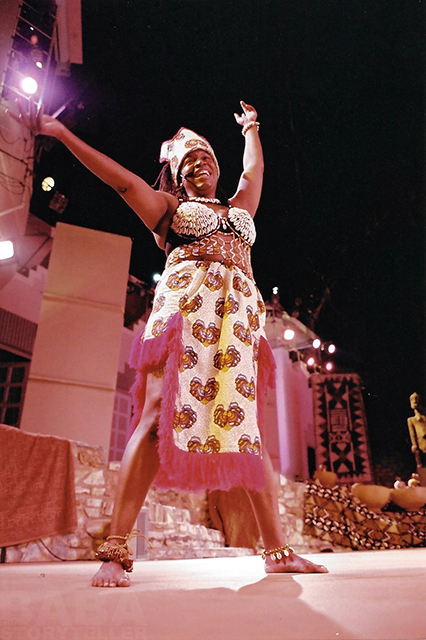
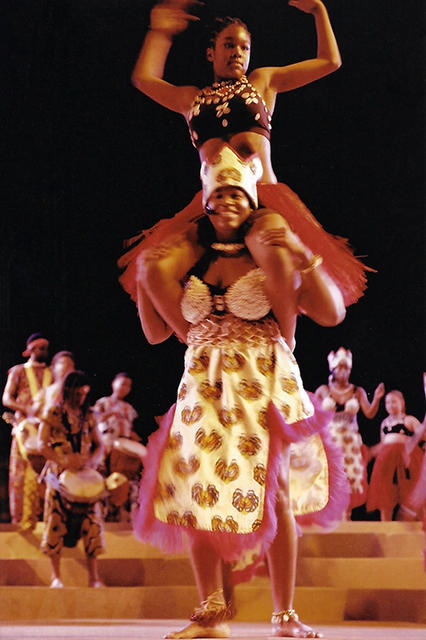
Manjani Sources
Darrin learned Manjani directly from the following Master Drummers and Dancers:
- Papa Ladji Camara and Koca Sale Dioubate from Les Ballets Africains
https://www.laphil.com/musicdb/artists/478/les-ballets-africains - Aboubacar "Oscar" Camara from Les Ballets Africains
https://www.facebook.com/aboubacaroscar.camara/ - Mamadi Keita (Attended his workshops in LA) https://en.wikipedia.org/wiki/Mamady_Keïta
- Omar Mboup
- Boujou Badialy Cissoko
https://www.facebook.com/boujoubadialycissoko/ - Dadisi Sanyika
https://oac.cdlib.org/findaid/ark:/13030/c8b85dnr/ - Leon Mobley
https://en.wikipedia.org/wiki/Leon_Mobley - Yaya Quarles, Darrin’s first teacher
Darrin has performed Manjani as a member of or performed with the following African Drum and Dance Troupes:
- Dembrebrah Drum and Dance Ensemble
https://dembrebrah.com/ - Teye Sa Thiosanne African Drum & Dance Company
https://www.actaonline.org/profile/teye-sa-thiosanne-african-drum-dance-company/ - Mori Nimba West African Dance Company
https://digital-collections.csun.edu/digital/collection/Bradley/id/15458/rec/1 - Sona Sané Drum and Dance Ensemble of Los Angeles, CA
- Jaliyaa West African Drum and Dance Ensemble of Los Angeles, CA
- The Ali Baba Band of Los Angeles CA
https://www.gigtown.com/artists/ali-baba-the-blessing-band - Kawambe-Omowale African Drum & Dance Theatre
https://www.kawambeomowale.com/ - Boujou Nomad - African Djeli Band
I have drummed Manjani for the following African Dance Teachers:
- Ndella Diassy - Long Beach Cultural Center
- Lisa Williams - Marcus Garvey School
- Carol Ababa - Long Beach Cultural Center
- Alesa "Mama Alake" Lott - Long Beach City College
- Nikkanni Shawishi - Cal State University
- Margery Phillips - Compton Community College
- Nzingha Camara - Santa Monica Community College / CSU Long Beach
- Mariam Faye - The Dance Collective - Leimert Park Los
- Muslimah Hameed - City of Phoenix - East Lake Park
- Evette Minns - City of Phoenix - East Lake Park
I also used the following reference resources:
- Billmeier, Mamady Keita: A Life For the Djembe—Traditional Rhythms of the Malinke. 1999. Engerda, Germany: Arun-Verlag.
- Keita, Balandugu Kan, 2000.. Fonti Musicali, FMD 218.
- “MENDIANI.” Reynders-Bonhagen.nl, 2022, www.reynders-bonhagen.nl/ritme/mendiani.html.
- “Mandebala.net Manjani.” net, 2012, www.mandebala.net/references/manjani.php.
- Sunkett, Mandiani Drum and Dance: Djimbe Performance and Black Aesthetics from Africa to the New World, 1995. White Cliffs Media, Tempe, AZ.
Darrin may be contacted at drum@bigzuzu.com.
